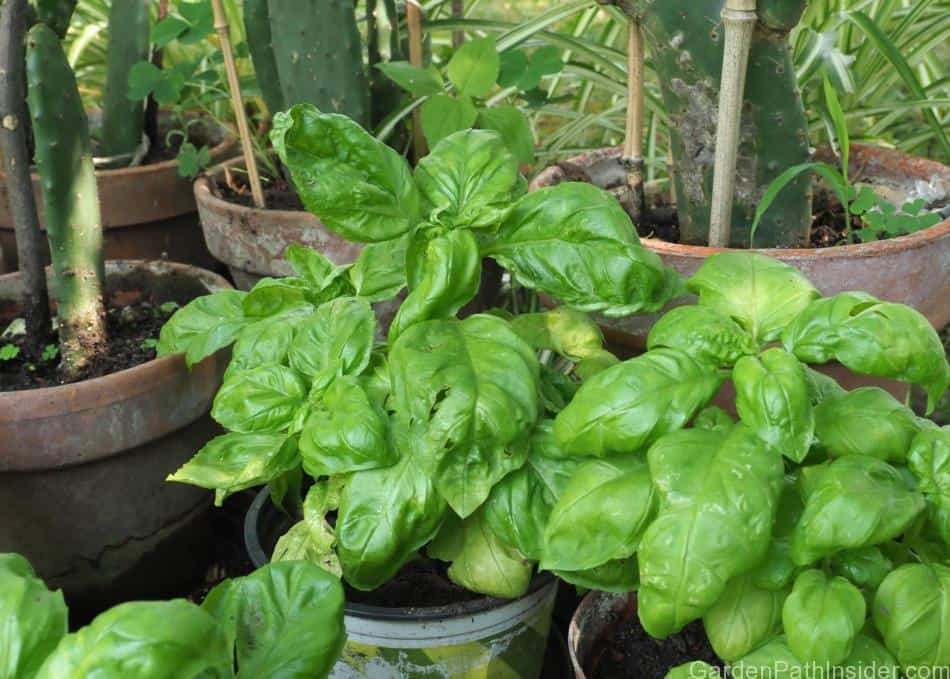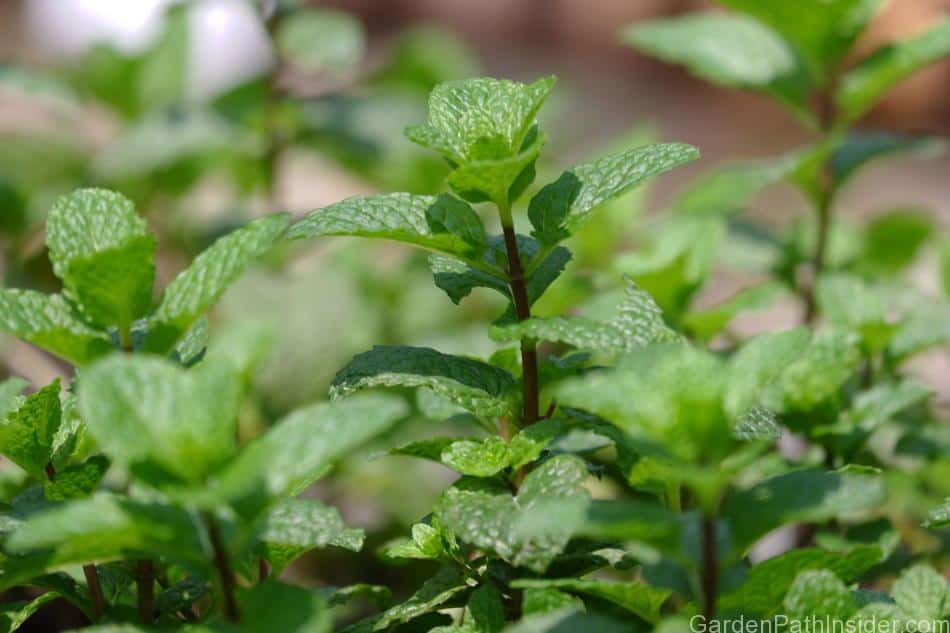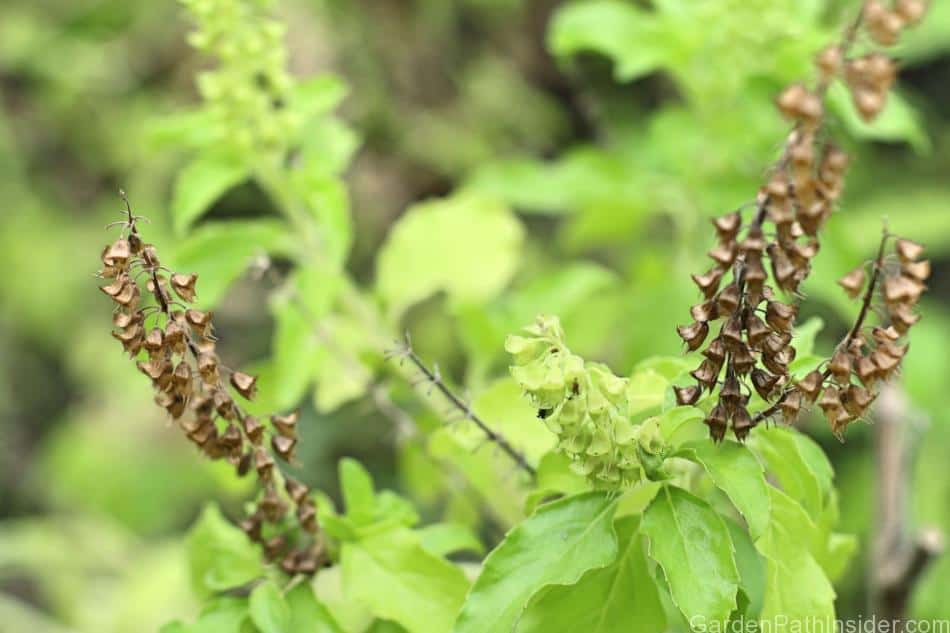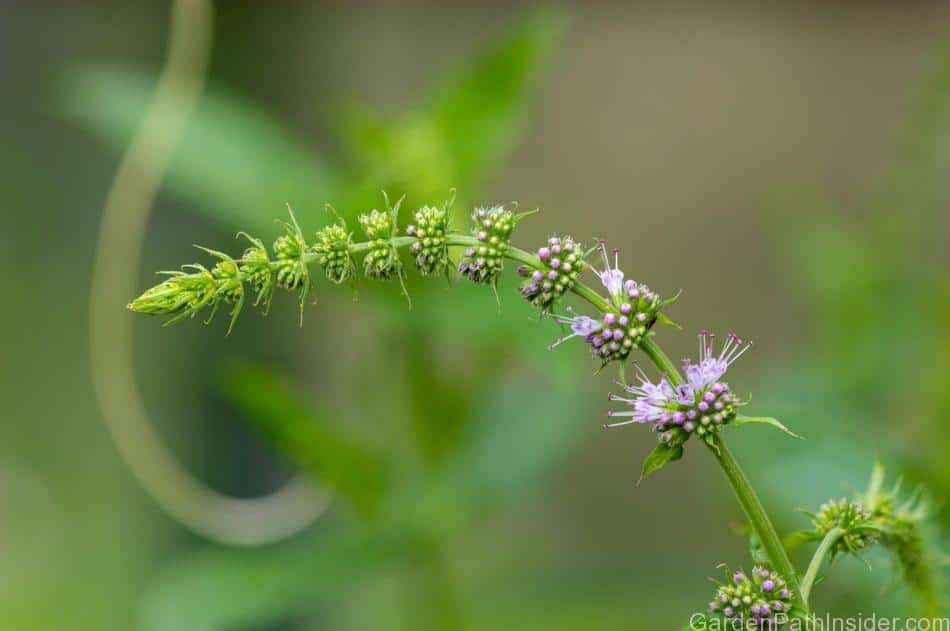
Fresh mint and basil are fragrant flavorful herbs that are easy to grow, maintain, and enjoy. As companion plants mint and basil are great to grow side by side in your herb garden.
Mint and basil should not be planted together in the same container or garden bed, as mint is an invasive species and will spread rapidly if the mint roots are not routinely cut back. Mint and basil are great companion plants to grow next to each other in separate growing spaces as mint can repel pests like aphids and beetles that would damage tender basil leaves.
Growing mint and basil together is a rewarding process and a great introduction to companion gardening. With the right materials and growing conditions, you can enjoy these fresh herbs in your kitchen in no time!
Mint and Basil Companion Plantings
Mint and basil are companion plants and can help each other thrive when grown side by side. Mint is a deterrent for several small insect pests like aphids and beetles. Different varieties of mint can repel different insects, as mint varieties range in fragrances.
Mint and basil also require the same growing conditions for soil, water, and light; making them easy to care for together. We will cover these growing conditions below.
Most gardeners, myself included, do not recommend planting mint and basil in the same container or garden bed as mint is a quick-spreading invasive species. As the mints root system grows, it sends out roots horizontally in the soil called runners or rhizomes.
Mint is hardy and can easily take over any growing space within a growing season. If you are planting mint and basil in the same growing space, you can use a garden barrier planted between the plants to keep the mint roots from choking and killing the basil root system.
Garden bed barriers are long strips of metal or plastic buried just below the soil level to contain the spreading of plant roots. Mint roots grow shallow, so you do not need to dig a barrier more than 6 inches (15cm) deep. You can buy garden barriers online, at your local home store, or you can make your own with scrap materials you may have around the house.
Are you planting a kitchen herb garden? See our article resource on growing rosemary as a companion plant to mint. Rosemary is a wonderful herb that can be added to savory dishes like, chicken, pasta, and even topped on pizza crust. Read more here: Can Mint and Rosemary Be Planted Together?
Mint Varieties
Mint is a perennial that thrives in full sun and well-draining fertile soil. Mint grows up to 36 inches tall (91cm) in some varieties and is an invasive species that spreads quickly, providing fresh mint leaves all season. Mint comes in many varieties that have unique flavors and fragrances. If different mint varieties are planted too close to each other, they can cross-pollinate and each variety will lose its unique flavors and fragrances.

Some of my favorite varieties of mint are listed below. Mint varieties range in many flavors and can be great accents to iced teas or other foods.
- peppermint (Mentha piperita L.)
- apple mint (Mentha suaveolens)
- pineapple mint (Mentha suaveolens variegate)
- orange mint (Mentha piperita citrate)
Basil Varieties
Basil is an annual that develops large tender leaves with a sweet unique taste and are used in many different dishes, from salads to pasta sauce. Basil grows to a height of about 36 inches (91cm) and blooms small flowers in the summer.
Basil needs to be grown in warm temperatures around 60°F to 70°F (15°C to 21°C). during the day, and temps that stay above 45°F to 50°F at night (7°C to 10°C ).
Basil is not a hardy plant and will not survive a frost or extended cold temperatures. Basil does spread slightly as it grows during the season. However, this plant will not take over garden beds with the same ferocity as mint.
Basil can be found in several varieties with unique flavors and fragrances. Growing several varieties of basil together in close proximity may cause cross-pollination of the flowers and the different varieties will lose their unique flavors as the cross-pollinated plants develop.
Below are some of my favorite types of Basil to use in the kitchen:
- Sweet basil (Ocimum basilicum)
- Cinnamon basil (Ocimum basilicum Cinnamon)
- Lemon basil (Ocimum x africanum)
Sweet basil has a refreshing taste and is often paired with mozzarella cheese, tomatoes, and a balsamic vinaigrette for a quick and light meal. Our container garden often includes at least one variety of tomatoes in addition to our sweet basil.
If you are interested in expanding your container garden and would like to enjoy fresh produce year-round, read our article resource on growing tomatoes indoors year-round. In the article, we describe the path to a successful and fruitful indoor tomato garden.
Read more here: Can You Grow Tomatoes Indoors Year-Round?
Growing Requirements for Mint and Basil
Mint: Container and Garden Bed Requirements
Mint can reach the height of 36 inches (91cm) in some varieties and grows fast enough to overtake a growing space in a single season. Mint grown in container gardens will grow to the full available space in the container, a large container of mint will provide plenty of mint for meals or Iced teas through the season.
Mint roots do not grow deep so your container does not need to be deeper than 6 to 8 inches (15cm to 20cm). The shape of the container will not impact the health of the plant so look for a container that fits your growing space.
If you are growing mint outside in a garden bed it is highly recommended that you install a garden bed barrier.
Garden bed barriers are long thin strips of metal or plastic that are buried just below the soil level, laid in a perimeter around the Mint to keep the invasive plant from overtaking a garden.
Mint roots do not grow deep in the soil, so you will not have to place barriers more than 6 to 8 inches (15cm to 20cm) in the ground. Garden bed barriers can be found online or at your local home store.
Basil: Container and Garden Bed Requirements
Basil is an easy to care for herb, that can be grown in container gardens or garden beds. A single store-bought basil plant will not invasively spread like a mint plant, making basil a great herb to plant anywhere in a garden bed. Basil does not need to be grown in a large container or pot to thrive.
Basil does best in smaller containers that have less soil, as too much soil can hold excess water and drown the roots. A single store-bought basil plant will grow well in a pot that is 6 to 8 inches (15cm to 20cm) in diameter, and 6 to 8 inches (15cm to 20cm) inches deep.
Soil Needs for Basil and Mint
Both basil and mint require well-draining fertile soil. The soil should be loose enough to allow the small roots to easily spread and develop the plant. If you have compost available, you can mix one-part compost with one part topsoil for a great fertile growing medium for the two plants. Store-bought soil works great for indoor gardens or container gardens.
Water Needs for Basil and Mint
Mint and basil need damp and slightly moist soil to thrive. Water daily as needed in normal weather, and water twice a day in the extreme summer heat. Basil is especially sensitive to drought, and the leaves will start to shrivel as soon as the plant starts to get dehydrated.
To test the soil moister press your finger in the soil a few inches away from the root system. Be careful not to press too deep, damaging the roots. Water when the soil feels like it is slightly dry to the touch. Too much water sitting in the roots can quickly kill a basil plant, while mint is slightly hardier to water and weather.

Pro Tip: Before you harvest basil make sure the plant has been watered thoroughly. Leaves on a well-watered basil plant will be plump, crisp, and tender; while leaves in a thirsty basil plant will be wilted, soft, and stringy.
Light Needs for Basil and Mint
Basil and mint both need full sun (6 to 8 hours) each day. In warmer climates, plant basil in an area that gets sun in the first part of the day; with shade later in the afternoon when temperatures reach their peak.
Basil and mint grown indoors should be placed by windows that will get the full days sun. Avoid placing your container garden near heating elements like space heaters, ovens, or heating vents.
When Can You Harvest Basil and Mint?
Mint leaves are best when harvested once the plant has established a well-developed root system. Mint leaves can be harvested as soon as they develop on the plant. However, it’s best to wait for the plant to grow a few inches tall before picking off the leaves. Too many leaves taken from the plant too early in the development will stunt its growth and delay maturation.
Basil leaves are also best harvested once the plant has established its root system. Some varieties of basil can grow several feet tall, though most stay well below that.
To increase the number of leaves each basil plant grows you can pinch off the new growth at the top of the plant once the plant reaches 8 to 12 inches (20cm to 30cm). Nipping the new growth at the top of the plant will cause the plant to grow bushy with more branches and leaves.

Pro tip: when harvesting leaves from basil and mint use a pair of scissors to snip the leaves off as close to the stem as possible. This will avoid tearing or damaging the branch of the fragile basil plant during harvest.
Below is a quick view summary of both mint and basil needs for your reference.
| Plant | Soil type | Water needs | Light needs | Bloom time | Harvest time |
| Mint | Loose well-draining fertile soil | Keep the soil slightly damp to moist. Water as needed. | Full sun | Spring/Summer | Mint leaves are edible at any time, though its best to wait until plants gets at least 6 inches tall (15cm). |
| Basil | Loose well-draining fertile soil | Keep the soil slightly damp to moist. Water as needed. | Full sun | Summer | Basil leaves are edible at any time, though its best to wait until plants gets at least 6 inches tall (15cm). |
Looking to expand your herb garden but you’re running out of space? We have a solution for you. Growing lavender in hanging baskets is a great way to introduce the fragrant herb into a garden of any size.
Our resource article will guide you on the best ways to incorporate and maintain hanging lavender into your garden. Read more here: Can You Grow Lavender in Hanging Baskets?
Cover image: Sweet basil plant (scientific name Ocimum basilicum)_© claudiodivizia/123rf.com
